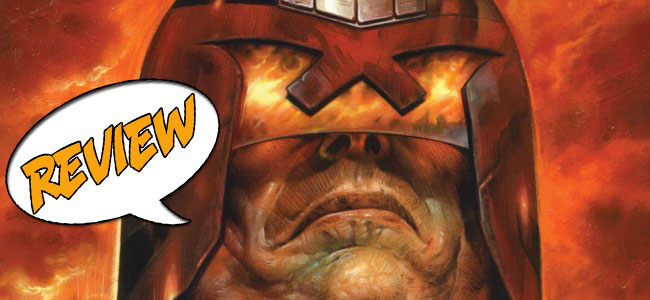Judge Dredd is on a mission to save Mega-City One from a psychic entity that has bewitched the city’s youths, giving them epic psychic powers. Is this really a deity come to Mega-City One’s sister dimension or is there more just below the surface? Major Spoilers jumps in to find out!
SUMMARY
Pros
Good concept for Judge Dredd
Yay for reimagined urban decay!
Cons
Hasty ending
Word balloons hide the art
[rating:overall]
READER RATING!
[ratings] JUDGE DREDD: YEAR ONE #4
JUDGE DREDD: YEAR ONE #4
Writer: Matt Smith
Artist: Simon Coleby
Letterer: Gilberto Lazcano
Editor: Chris Ryall
Publisher: IDW Publishing
Cover Price: $3.99
Previously in JUDGE DREDD: YEAR ONE: Judge Dredd headed into an alternate dimension where Mega-City One has been ransacked and destroyed by an entity known as the Four Mothers. With another judge named Hopper as his only guide, Dredd has to fight off trogs and navigate the undercity in order to get to stop the Four Mothers before it attacks the Mega-City of his own universe. Meanwhile, the Juves revolt against the adults, causing havoc and chaos as their psi-powers continue to develop.
PAY NO ATTENTION TO THAT MAN BEHIND THE CURTAIN
Dredd and Hopper arm themselves with the few remaining judges to go and lay siege to the Four Mothers, attempting to stop the menace before it spreads to his own Mega-City One. Ever the realist, Dredd believes there’s more to this supposed deity than everyone believes, unearthing a huge operation meant to distract and subjugate the masses.
Judge Dredd is one of those series that, despite its futuristic setting, tends to frown on the element of magic and the paranormal. While not necessarily a new element introduced to the Dredd series, mutants and the psychic abilities thereof have been greatly amped up and have become the primary focus for the Year One books. And it works really well. It has worked well all the way up to this point.
However that idea of magic and a power greater than one’s self is immediately killed towards the end of the book, which feels a bit like a rushed ending. The explanation for why things have transpired as they have seems hastily drawn up and is resolved as quickly as it’s introduced. While Dredd isn’t necessarily known for his exposition, it was all resolved way too quickly, making it feel a bit more like Smith had to meet a deadline and instead of focus on his pacing.
SHADOW PLAY
Simon Coleby does a pretty good job as a Judge Dredd artist. Coleby’s art is a far cry from the original Judge Dredd art style, but still manages to pay homage to the first Dredd comics. There is a sense of dirt, grit, and all around urban decay that one would expect to find in a Dredd series, but Coleby updates that, bringing in heavy shadowing and a less intense attention to detail, allowing the mind to fill in most of the aforementioned dirt, grit and urban decay. Unfortunately, because of the over abundance of word balloons, a lot of the art is covered up and Coleby doesn’t necessarily get as much face time as he should.
BOTTOMLINE: IT’S PRETTY GOOD
For many people first coming to the Judge Dredd universe, this run so far has been a good way to go. It’s been vastly entertaining and this story-arc gives an interesting look into Dredd’s first years as a judge. While the ending was too hasty and a lot of the art was overshadowed by tons of word balloons, it’s an interesting look at the Dredd mythos for someone who’s a newcomer. Even with the abrupt end, it’s still an enjoyable read. Overall, Judge Dredd: Year One #4 earns three stars out of five.
[rating:3/5]



1 Comment
I’ve enjoyed Year One more than IDW’s on going series which seems to have struggled to find it’s feet. Smith and Coleby know their Dredd and it really comes through in the strip I especialy enjoyed seeing a different take on an iconic charecter stripping away a lot of the baggage he has aquired over the the years.
I agree with you about the ending, “oh, it was just a bunch of inter-dimensional conartists” seem like a copout but overall there was enough for me to like that I hope the continue the series.